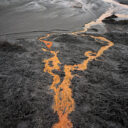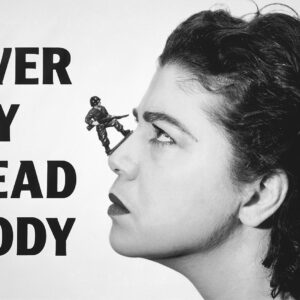Frutto di una vita vissuta ovunque e in nessun luogo, Castro è la straordinaria combinazione di rabbia e ironia, studio e attivismo, poesia e provocazione. Dal sarcasmo spiazzante ma sempre calibrato – da giurista ex diplomatico quale è -, Castro è un radicale interprete della nostra epoca, un indomito esploratore delle interferenze tra produzione artistica e azione politica, tra iniziative individuali e partecipazione collettiva, tra legalità e illegalità, tra democrazia e terrore. Per proporre nuove vie di lucida resistenza.
Jota Castro affronta temi delicati come i conflitti sociali e le problematiche planetarie con sarcasmo e profondità, alternando astuta diplomazia a graffiante ironia. Il suo più grande pregio è quello di riuscire a illustrare concetti complessi in maniera chiara e penetrante, magari semplicemente accostando tra loro oggetti disparati ma dall’alto valore simbolico. I suoi lavori dimostrano ancora una volta come una sola immagine sia più efficace di mille parole e come gli artisti possano ritagliarsi un ruolo sociale e politico anche in questa contemporaneità così complessa e contraddittoria.
Proveniente da uno sperduto paesino del Sudamerica (Yurimaguas) che, a suo dire, nel 1965 (suo anno di nascita) non era segnato nemmeno nelle carte geografiche, Castro si dimostra fin da giovanissimo inquieto e desideroso di conoscenza. Con una borsa di studio arriva in Francia e da lì non si è più fermato. Ha girato il globo prima come diplomatico poi come artista, osservandolo con uno sguardo politico radicale e seguendo un unico imperativo: dire quello che pensa nel modo più efficace possibile. A Castro va infatti riconosciuta la ricerca della sintesi visiva, quella che riesce a racchiudere un’idea con un’immagine che rimane stampata sulla nostra retina e nella nostra mente. Un retroterra culturale, quello di Castro, che guarda al readymade di Marcel Duchamp, all’Arte povera italiana e all’arte concettuale internazionale, non da ultima quella sudamericana. Penso, ad esempio, a un artista come Cildo Meireiles che, nel 1970, aveva stampato su banconote e bottiglie di vetro della Coca-Cola messaggi politici contro il regime militare e che, negli anni Ottanta, ha realizzato opere come Mission/Missions (How to Build Cathedrals), composta da monete, ossa e ostie: un’istallazione che denunciava i crimini perpetrati dai missionari nelle colonie americane.
I suoi lavori sono stati presentati nei quattro angoli del mondo, dalla Biennale di Gwandju in Corea (dove ha vinto il primo premio nel 2004) a quella di Venezia, Tirana e Praga; ha realizzato mostre personali in musei o gallerie in Europa (a Bruxelles in particolare, dove vive e lavora), in America del Nord e del Sud fino in Australia. Ma soprattutto ha un legame particolare con la città di Napoli, dove ha dato vita con la Galleria di Umberto Di Marino a mostre molto significative, da ultima Cave Canem (ottobre 2018) disseminata in diversi punti della città: Castel Sant’Elmo, l’Ipogeo di Santa Maria delle Anime del Purgatorio ad Arco, la Chiesa di San Giuseppe delle Scalze a Pontecorvo e il Riot Studio. “[Qui] mi sono sentito bene e male allo stesso tempo. Meravigliato per la città, per le sue contraddizioni, il suo passato, e l’impressione per cosa poteva essere il futuro. […] Napoli è un laboratorio del sociale… qui tutto il mondo è arrivato e tutto il mondo è partito”.
Per capire Castro e la sua critica radicale del presente, bisogna partire dalle sue opere: da Private Dancer (una specie di palo da lap dance fatto con banconote da un dollaro), da Seguro (un grande “smile” realizzato con due specchi convessi – di quelli che si usano per controllare gli angoli di strade e palazzi -, un manganello come naso e un paio di manette a disegnare una bocca sorridente) o da Lagrimas Negras (la riproduzione in scala di una macchina per l’estrazione del petrolio tinteggiata di un giallo oro), lavori che potremmo definire icastici e che possono aiutarci a guardare le cose e il mondo in modo diverso.
La strategia comunicativa di Castro è lo spiazzamento, lo shock mentale più che visivo, che serve a innescare riflessioni profonde e ad attivare punti di vista differenti rispetto alle questioni critiche del nostro tempo, offrendo allo spettatore nuove possibilità di sguardo e di pensiero.
Basta uno specchio a raggiungere l’obiettivo: usandolo come materiale per comporre le lettere della parola “Borders” nella quale ci riflettiamo (la prima frontiera da superare siamo noi stessi!), oppure utilizzandolo come fondo di una culla per bambini (Leche y Ceniza). Affacciandoci sul lettino non solo vediamo il nostro volto (noi da bambini? la nostra infanzia?) ma percepiamo che quelle sbarre possono trasformarsi in prigione, tratteggiando l’immagine di un’infanzia presa in ostaggio.
Le sue opere si aprono a molteplici interpretazioni, letture diverse ma sempre tese a toglierci da una situazione di comfort. Non a caso una sua mostra da Umberto di Marino (2013) si intitolava Gemütlichkeit, una parola tedesca che sta ad indicare quel senso di calore e socievolezza che, facendo dimenticare le difficoltà, porta in uno stato di quieto benessere.
Un umorismo a volte triviale e un sarcasmo politicamente scorretto servono a Castro per “provocare la curiosità… e quindi il sapere” (come afferma lui stesso), o a farci sentire dalla parte scomoda, dalla parte dei discriminati, come nella performance Discrimination Day al Palais de Tokyo di Parigi nel 2005, quando ha ostacolato l’ingresso al museo di tutti quei visitatori (i bianchi europei) che nella loro vita non avevano mai sperimentato una situazione di razzismo o segregazione.
Per l’artista è giunto il momento di ripensare la nostra condizione, di immaginare una nuova realtà per l’essere umano e impostare la convivenza con la natura su altri principi, come sostiene quando parla di “Slow Future”. Anche il progetto dell’Unione Europea per Castro deve continuare, anche se fondato su altri principi (opere come Here Comes the Rain Again o London Calling denunciano proprio la fragilità di questo progetto politico). Secondo Jota Castro la forza per guardare al futuro potrà venire solo da quei popoli che hanno già sperimentato su di sé la forza dirompente della globalizzazione, come i popoli del Sud America hanno fatto cinquecento anni fa, o da una città come Napoli che, per l’artista peruviano, ha molto in comune con il mondo latinoamericano.
E qui torna dirompente anche l’idea di frontiera e di confine, tema che era alla base dell’intervista che gli feci nel 2007 per DROME magazine. Le sue parole restano di grandissima attualità e, credo, meritino di essere riproposte.
Silvano Manganaro: Alla fine degli anni Novanta hai deciso di abbandonare la tua carriera diplomatica che ti aveva portato a collaborare con L’ONU e l’Unione Europea per abbracciare quella artistica. Cosa ti ha spinto a fare questa scelta?
Jota Castro: “A questa domanda dò sempre la stessa risposta: perché abbiamo una sola vita! Quest’unica vita penso che vada vissuta in maniera intensa. Questo per me significa fare l’artista!”
Il tuo lavoro viene spesso definito “arte politica”. Le tue opere parlano di questioni sociali e politiche a livello planetario e quindi, inevitabilmente, di frontiere e confini (tra Paesi ricchi e poveri, tra il singolo individuo e ciò che viene considerato “straniero”, ecc.). Pensi che un’opera d’arte possa sollecitare l’agire politico, intervenire sulla società o, addirittura, cambiare il mondo?
“Fino ad ora nessuna opera d’arte ha mai cambiato il corso dell’Umanità, ma rimane ancora un sogno… Penso che oggi sia possibile tentare di spiegare qualcosa sulla nostra società usando l’arte come strumento d’indagine. L’arte è uno dei pochi spazi rimasti in cui si può parlare liberamente di questioni sociali senza alcun controllo. Per me l’artista ha un importante ruolo da giocare nella società, e questo è qualcosa di politico. La prima frontiera che mi auguro possa cadere è quella che separa l’Arte dalle scienze sociali. Scienze sociali, conoscenza, informazioni sono le mie matite e i miei pennelli… “
Non credi che l’arte sia, in un certo qual modo, sempre “politica” (nel senso più ampio del termine)? D’altronde, implica inevitabilmente una presa di posizione estetica e la scelta del ruolo dell’artista nella società contemporanea…
“Per me non è affatto un problema individuare il mio ruolo nella società: lo so perfettamente. Sono un artista, se la gente non lo capisce, non è un problema mio. E così torniamo sul problema delle frontiere… Quando l’arte è puramente estetica non crea problema, se invece si basa su idee e principi provoca continuamente difficoltà di comprensione. Oltrepassare questa frontiera è per me uno stimolo.”
Qual è la differenza tra fare arte e fare comunicazione (anche politica)?
“L’artista comunica le sue idee. Una persona che fa comunicazione molte volte trasmette idee o prodotti di altri. Si comunica per vendere un’idea o un prodotto del quale c’è bisogno o del quale si può creare il bisogno. Dell’arte non c’è bisogno.”
Le tue opere nascono dall’accostamento di due oggetti spesso molto lontani tra loro: un matrimonio che colpisce lo spettatore con la completezza di un aforisma e l’efficacia di una battuta di spirito. Qual è il processo mentale che sta alla base delle tue opere?
“L’inquietudine! Osservo, analizzo… Cerco sempre di immaginare un’opera capace di mettere in luce un problema. Generalmente, prima di realizzare concretamente l’opera, butto giù un progetto scritto. Se mi convince, passo alla realizzazione dell’opera. Basare il mio lavoro sull’osservazione di determinate problematiche mi fa sperare di poter lavorare tutta la vita: ogni giorno c’è un problema nuovo!”
Uno dei tuoi progetti più noti è probabilmente la creazione, insieme a Evelyne Jouanno, della “Biennale dell’Emergenza”, in cui il concetto di abbattimento di frontiere e avvicinamento tra luoghi distanti era fondamentale. Qual è il bilancio finale di questa esperienza?
“Intellettualmente è sempre un piacere concretizzare un’idea… ma per una serie di problemi personali ho dovuto lasciare il progetto… sono cose della vita! Questo progetto, però, mi ha convinto della necessità di lavorare sulla nozione di Urgenza. Credo che gli artisti debbano occuparsi della contemporaneità, della necessità di interpretare gli eventi attuali, senza aspettare che un tema sia storicamente accettato per considerarlo rilevante come materiale.”
Qual è, secondo te, la frontiera che non andrebbe mai superata e quella che invece dovrebbe esserlo al più presto?
“La prima frontiera da superare dovrebbe essere se stessi. Ho realizzato un’opera che raffigura la parola “BORDERS” scritta con lettere specchianti. La prima frontiera è quella che si vede nello specchio: se stessi. Per il resto, non vedo barriere da non superare. Per me, se c’è una frontiera significa che c’è qualcosa da superare, bisogna andare verso ciò che sta dall’altra parte e viceversa…”
The continuation of politics through other means
The result of a life spent everywhere and nowhere, Castro is the extraordinary combination of rage and irony, study and activism, poetry and provocation. From the unsettling but always balanced sarcasms – as the lawyer, formerly diplomat he is – Castro is a radical interpreter of our times, an indomitable explorer of the interferences between artistic production and political action, individual initiative and collective participation, legality and illegality, democracy and terror. All this offer new paths of lucid resistance.
Jota Castro tackles delicate subjects such as social conflicts and worldwide problematics with sarcasm and depth, alternating sly diplomacy with biting irony. His greatest virtue is being able to depict complex concepts in a clear and effective way, at times simply pulling together different objects with a deep symbolic value. His works show once again how a single picture can be more effective than one thousand words and how the artist can play a social and political role even in this complex and contradictory contemporaneity.
Hailing from an isolated village of South America (Yurimaguas) which, in his opinion, in 1965 (his year of birth) was not even marked on the maps, Castro proves to be from an early age restless and yearning for knowledge. Thanks to a scholarship he arrives in France and from that point he never stopped. He travelled the world first as a diplomat and then as an artist, looking at it with a radical political gaze and following a single rule: always saying what he thinks in the most efficient way. We must acknowledge Castro the research of the visual synthesis, capable of enclosing an idea with an image that remains imprinted in our eyes and mind. A cultural background, inspired by the readymade of Marcel Duchamp, the Italian Arte povera and the international conceptual art, not least South American art. Think about, for example, an artist such as Cildo Meireiles, who, in 1970, printed on bills and glass bottles of Coca-Cola political slogans against the military regime, and who in the 1980s realized works like Mission/Missions (How to Build Cathedrals), made up of coins, bones and hosts: an installation denouncing the crimes committed by the missionaries in the American colonies.
His works have been displayed around the four corners of the world, from the Gwandju Biennale in Korea (where he won the first prize in 2004) to the Biennales in Venice, Tirana and Prague: he realized personal exhibitions in museums and galleries in Europe (particularly in Brussels, where he lives and works), in North and South America, reaching Australia. But above all he has a special relationship with Naples, where he organized with the Umberto Di Marino Gallery several meaningful exhibitions, the last one Cave Canem (October 2018), spread in various parts of the city: Castel Sant’Elmo, the hypogeum in Santa Maria delle Anime del Purgatorio ad Arco, the Church of San Giuseppe delle Scalze in Pontecorvo and the Riot Studio. “Here, I’ve felt good and bad at the same time. Amazed by the city, by its contradictions, its past, and the impression of what the future could be. Naples is a social laboratory, here the whole world has arrived and from here it has departed”.
In order to understand Castro and his radical critique on present times, we must begin from his works: from Private Dancer (a sort stripper pole made with one-dollar bills), from Seguro (a huge “smile” realized with two curved mirrors – the kind used to check the corners of streets and buildings – a baton for nose and a pair of handcuffs shaping a smiling face) or from Lagrimas Negras (a scale reproduction of an oil drill machine painted in golden yellow), works that we could define incisive and that can help us look at things and the world in a different way.
Castro’s communicative strategy is the disorientation, a mental, more than visual, shock, necessary in order to trigger deep reflections and activate different points of view toward critical questions of our time, offering the observer new possibilities of view and thought.
All it needs to reach the goal is a mirror: using it as a material to spell the letters for the word “Borders” into which we reflect (the first border to overcame is ourselves!) or using it as the bottom of a crib (Leche y Ceniza). Looking into the crib with see not only our face (ourselves as children? our childhood?) but we also perceive that those bars can become a prison, tracing the image of a childhood taken hostage.
His works are open to multiple interpretations, different readings yet always directed at taking us away from a comfortable situation. It is not by chance that one of his exhibitions at the Umberto di Marino Gallery (2013) was titled Gemütlichkeit, a German word describing that sense of warmth and sociability that, making us forget our difficulties, brings us a state of serene wellness.
A sense of humor at times vulgar and a politically incorrect sarcasm allow Castro to “provoke curiosity… and therefore knowledge” (as he personally declares), or to make us feel on the uncomfortable side, on the side of the outcasts, like in the performance Discrimination Day at the Palais de Tokyo in Paris in 2005, where he blocked the entrance of the museum to all those visitors (white Europeans) who had never experienced in their life a situation of racism or segregation.
For the artist, the moment has come to rethink our condition, to imagine a new reality for the human being and set up the cohabitation with natures on other principles, as he claims when he talks about “Slow Future”. For Castro, even the project of the European Union must continue, even if based on other principles (works such as Here Comes the Rain Again or London Calling denounce precisely the fragility of this political project). According to Jota Castro, the strength to look at the future can only come from those populations who have already directly experienced the devastating strength of globalization, like the populations of South America, five hundred years ago, or from a city like Naples that, for the Peruvian artist, has much in common with the Latin American world.
And here returns the disruptive idea of frontier and border, a subject at the core of the interview I did in 2007 for DROME Magazine. His words remain of great modernity and, I believe, they deserve to be proposed again.
Silvano Manganaro: At the end of the 1990s you decided to abandon your diplomatic career which led you to work for the UN. and the European Union, to embrace the artistic career. What pushed you to make this choice?
Jota Castro: “I always give the same reply to this question: because we only have one life! This single life, I believe we must live it fully. For me, this is what means to be an artist!”
Your style is often defined “political art”. Your works touch social and political subject on a global scale and, as an inevitable consequence, they talk about frontiers and borders (between rich and poor countries, the single individual and what is considered “stranger”, etc.) do you believe that a work of art can stimulate political action, intervene on society or even change the world?
“So far, no work of art has ever changed the course of Humanity, this remains a dream…
I believe that today it is possible to try to explain something about our society using art as a research tool. Art is one of the few spaces where we can still talk openly about social subjects without any censorship. For me, the artist has an important role to play in society and this is something political. The first frontier I hope can crumble is the one separating Art from social sciences. Social sciences, knowledge, information are my pencils and my brushes…”
Don’t you agree that art is, in some ways, always “political” (in the broader sense of the term)? Besides, it inevitably implies an aesthetic stance and the choice of the role of the artist in the contemporary society…
“Finding my role in society is not a problem at all for me: I know it perfectly. I am an artist, if people do not understand that, it is not my problem. Thus, we return on the issue of borders… When art is purely aesthetic it does not create a problem, if instead it is based on ideas and principle it continuously creates difficulties in understanding. For me, crossing this frontier is an incentive.”
What is the difference between making art and making communication (even political)?
“The artist conveys his own ideas. A person making communication often wants to convey other people’s ideas or products. You communicate to sell an idea or a product which is needed or of which the need can be created. There is no need for art.”
Your works are born from the combination of two object that are often very different from each other: a marriage that strikes the observer with the completeness of an aphorism and the effectiveness of a witty joke. What is the thought process at the core of your works?
“Apprehension! I observe, analyze… I always to imagine a work capable of highlighting an issue. Before I concretely realize the piece, I write down a project. If I am convinced, I switch to the realization of the piece. Basing my work on the observation of certain issues makes me hope to work all lifelong: every day there is a new problem!”
One of your most famous projects is probably the creation, together with Evelyne Jouanno, of the “Emergency Biennale”, where the concept of tearing down frontiers and bringing distant places closer was fundamental. What is the final analysis on this experience?
“Intellectually, it is always a pleasure concretizing an idea. However for a series of personal matters I had to leave the project… things that happen! This project, however, convinced me of the necessity to work on the notion of Urgency. I believe the artists must work on contemporaneity, on the necessity to interpret current events, without waiting for a theme to be historically accepted before considering it relevant as a subject.”
What do you think is the frontier that should never be crossed and the one that should instead be crossed as soon as possible?
“The first frontier to cross should be oneself. I realized a work representing the word “BORDERS” written with reflecting letters. The first frontier is the one we see in the mirror: ourselves. As for the rest, I can’t see uncrossable barriers. For me, if there is a frontier it means there is something to overcome, we must go towards what is on the other side, and vice versa…”








No Comments